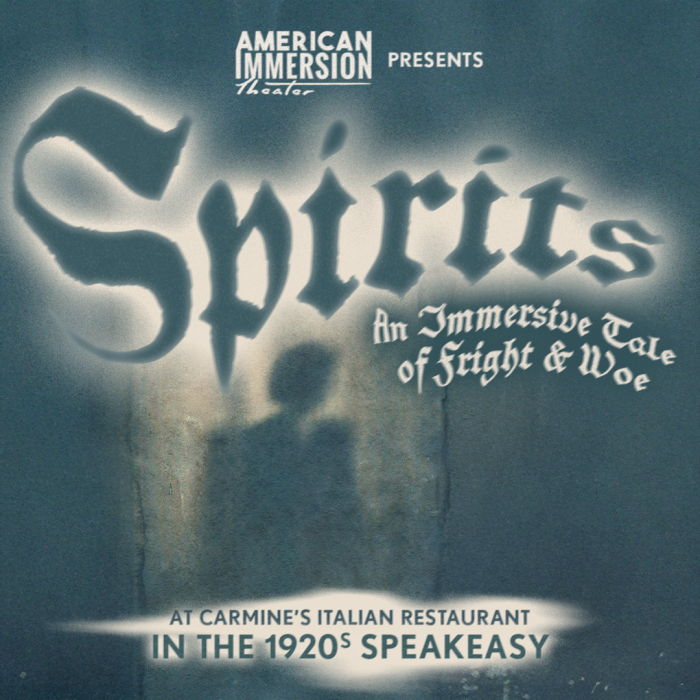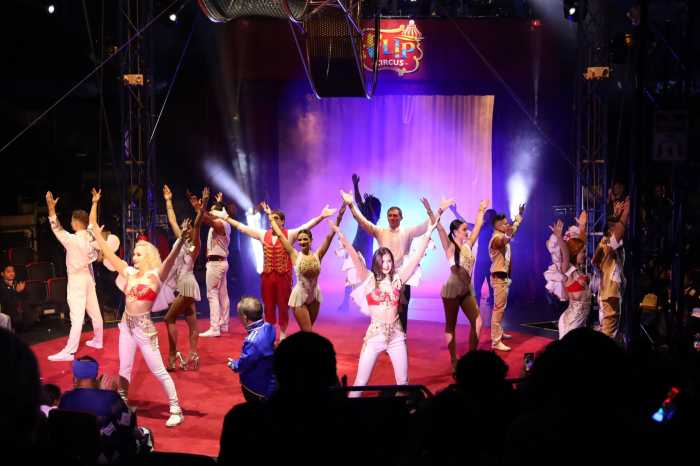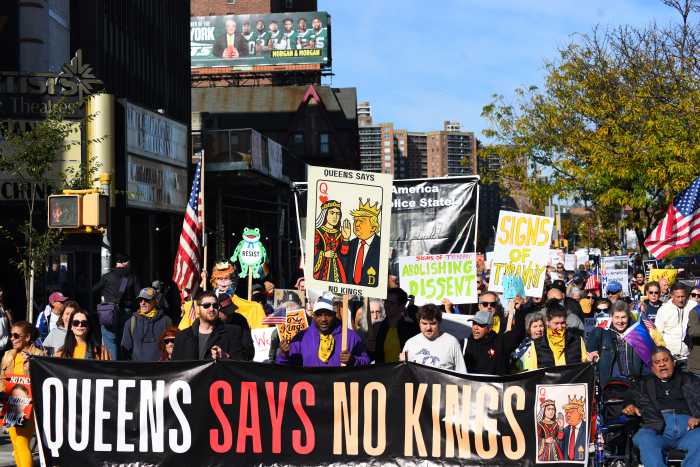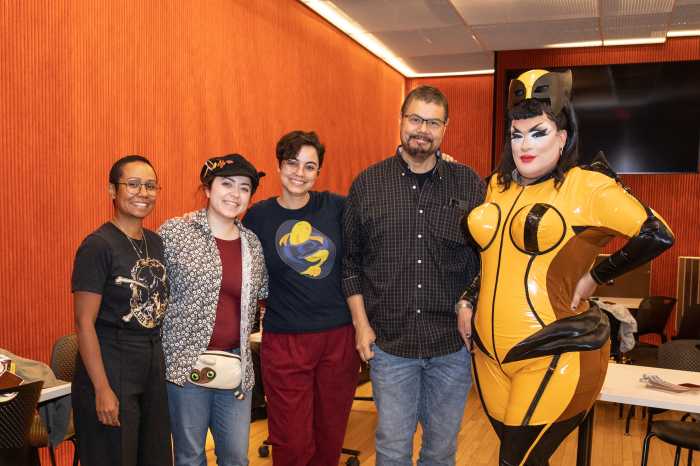Koch spins for the right wing
To The Editor:
Former Mayor Ed Koch’s characterization of “Fahrenheit 9/11” as cheapening the national debate and comparing it to a glory piece on Hitler is endemic of the propaganda campaign that the rightwing conservatives have launched in this country (Koch on Film, July 7). Michael Moore created an important film that exposes many of the serious problems with the Bush presidency. It is apparent that this material hits close to home, as Republicans are frantically scrambling to discredit the film and Michael Moore.
As with most critics of “Fahrenheit 9/11,” instead of refuting the major accusations that Moore makes in the film, Mr. Koch takes Moore to task over a minor detail. Just for the record, the six-month media consortium study did not decisively declare that Bush won the election. The study found that using any standard that tabulated all disputed votes statewide, Mr. Gore erased Mr. Bush’s advantage and emerged with a tiny lead that ranged from 42 to 171 votes. There are references and links to the original article and the report on Michael Moore’s Web site —www.michaelmoore.com.
Because there is an overwhelming amount of evidence presented in “Fahrenheit 9/11” that demonstrates how the president made critical missteps in the wake of the 9/11 attack, it is no wonder that Moore is screaming mad. I am screaming mad as well, especially when I found out that Mr. Bush and staff put off meeting with the head counter-terrorism advisor for nine months and that Bush spent 42 percent of his first eight months in office on vacation, not to mention the dubious financial relationship with the Saudis. I don’t hear any of the film’s critics disputing these facts.
I encourage those who have not yet seen “Fahrenheit 9/11” to go out and see the film. If you doubt any of the material that is presented, don’t rely on Ed Koch, the poster boy for the Republican National Convention, to clarify them for you. Do your own research and come to your own conclusions about what is presented in the film. Even if you decide that half of it is true, that is still quite a bit to be screaming mad about.
Linda Giordano
Market needs Grade A planning
To The Editor:
The July 14 Meat Market issue of The Villager offered great insight into the challenges facing this neighborhood. However, on the issue of zoning and residential uses, it neglected to make clear several important facts:
If the zoning in the Meat Market were changed from the current manufacturing zoning to allow residential development, both old and new bars and clubs would still be allowed under any existing zoning district that could be applied in this area. Neighborhoods such as Soho and the Flatiron District are former manufacturing zones like Gansevoort Market where zoning changes introduced new residential uses years ago; today, they have some of the highest concentrations of bars and/or clubs anywhere in the city, some of which have been the source of considerable conflict with neighbors, showing that residential development does not offer a cure-all to noisy bars or clubs.
The Greenwich Village Society for Historic Preservation and many others successfully fought to keep a developer from erecting a 450-ft.-tall residential high-rise directly across the street from the largest concentration of Gansevoort’s meatpackers (most of whom in this immediate area are still staying); had we not succeeded and that plan gone through, those businesses would have no doubt been pushed out very quickly, and their spaces opened up, potentially for any of the new uses we see proliferating in the area. This project did not ask for a zoning change that would have resulted in any restriction of bar or club uses in the area.
G.V.S.H.P. and others also successfully fought a city ruling that would have allowed residential development to “sneak in” anywhere in the Meat Market as a part of hotel development, with the public having no say whatsoever about its appropriateness. With the defeat of this ruling, any owner can still ask for permission to convert to residential use on his or her site, but only through a public process that allows the community to have input on whether or not the residential development — and, in many cases, its size and scale — is appropriate for that location.
In 2002, G.V.S.H.P. asked the city to consider prohibiting new hotels in the Meat Market because of some of the use conflicts we feared might follow (incidentally, certain types of bars and clubs are only allowed in hotels).
In spite of most of the area’s buildings being saved by landmarking, Gansevoort Market clearly continues to face huge challenges to its future and its character. As new uses or developments are contemplated for the area, it has been our position that their impact upon the meatpackers, as well as a possible flower market (of which G.V.S.H.P. has been part of the effort to explore relocating to Gansevoort Market) must be strongly considered — both could be very seriously impacted by new residential development. For all of these reasons, G.V.S.H.P. earlier this summer asked the city to work with the community and elected officials to do comprehensive planning for the area, ensuring that desirable uses are encouraged and undesirable ones not. We hope they will listen. We look forward to working with groups focused on community, business, quality of life and traffic concerns to help shape this area’s future and protect its unique character and history.
Andrew Berman
Berman is executive director, Greenwich Village Society
for Historic Preservation and Save Gansevoort Market
Residents will butcher nightlife
To The Editor:
The history of our city in the last several decades is that neighborhoods that have been abandoned by manufacturing businesses and become deserted wastelands, have been revitalized by intrepid gallery owners, retail entrepreneurs and restaurateurs and nightclub operators who venture forth into uncharted territory.
Then, the Board of Standards and Appeals grants variances to powerful developers who want to capitalize on the “cool” factor provided by the pioneer, and residential buildings are all of a sudden thrown into the mix. And those residents nearly immediately realize the error of their decision to live in an area that is a thriving nightlife zone, and begin to complain to their community board, their precinct and every elected official they can find and demand that the nightlife be shuttered. Throw in the smoking ban, which has led to mobs of smokers in the streets, and a recipe for disaster is created.
However, in the Meatpacking District, after much fighting, the B.S.A. and Department of Buildings did the right thing and ruled against a residential variance.
Why on earth, after seeing the aforementioned pattern in Soho, Tribeca, the Flatiron District and other areas of Manhattan, would anyone think that throwing some apartments into the Meatpacking District would do anything other than create a virtual war zone?
The answer is…they don’t care. Yes, there are good people in this area who are honestly troubled by the effects of the increased traffic on the nearby residential districts, and they have justifiable concerns.
But others can try to mask their true ambition all they want, yet their real motivation…GREED…is readily on display.
The Meatpacking District, while still a viable meat market, is home to dozens of new stores, many new commercial and office tenants, several hotels and some of the most innovative restaurants and nightlife venues in New York. Nearly every week, a new business opens, at higher and higher rents.
Lest people forget, some people actually come to New York as tourists or move here as young people precisely because of the excitement of New York’s nightlife. In fact, the nightlife industry is a $9 billion (yes, billion) economic engine for our city, generating hundreds of millions of dollars in state and city taxes.
Whether or not there needs to be discussion as to the continued growth of the area and liquor licenses is one thing.
But, the idea that somehow allowing residences here will solve problems would be laughable if it weren’t so dangerous. A visit to any community board meeting at Community Board 3 or Community Board 5 will quickly make this clear.
The Meatpacking District is booming…the one thing it does not need is more overpriced housing…especially as the city plans to rezone the far West 20s. With nowhere else for nightlife to thrive without bothering legal residential tenants, we might as well just go to bed at midnight, lose several billion dollars in revenue and change our name to Cleveland.
David Rabin
Rabin is president, New York Nightlife Association and co-owner, Lotus
B.P’s. to blame for board conflicts
To The Editor:
Robert Weitz’s letter (“Bar owner as chair is last straw,” July 14) should inspire broad-based action to address rampant conflicts of interest in community board appointments.
I was for many years a public member of the Sidewalks and Business Committees of Community Board 2, which deals with applications for sidewalk cafes and liquor licenses, respectively. Over time, Borough President C. Virginia Fields approved more and more appointments of persons who owned, operated or provided business services to restaurants and bars. I and others questioned her and other elected officials about the potential conflicts of interest that could arise should these individuals serve on committees whose entire agendas consist of applications by their friends, colleagues or even their competitors for the business-friendly permits on which those committees vote.
(It’s important to point out that at no time was anyone’s right to board membership being questioned — merely the appropriateness of their serving on committees whose actions could critically sway the balance between residents’ and merchants’ rights in a neighborhood as greatly affected by restaurant and bar proliferation as is Community Board 2.)
None of our concerns were ever taken seriously. The committees were increasingly populated by these compromised appointments, and we received the same “willful blindness” responses from Ms. Fields’ office and from other elected officials as Mr. Weitz seems to be getting. More recently, two excellent public members of the C.B. 2 Sidewalks Committee who were ardent defenders of residents’ rights were removed from the committee by board management, furthering damaging its precarious balance.
Obviously, this particular buck stops at the borough president’s desk. There should certainly be strong pressure on Ms. Fields to discuss openly and frankly how her public-service philosophy accommodates the manipulation of community board business to serve relatively narrow special interests, especially ones that create major quality of life problems within the affected communities. Although she is term-limited as borough president, it would be important for her to start this discussion now in case she plans ever to ask for our votes again.
Mary K. Doris
Setting record straight on gay riot
To The Editor:
Re “Stonewall book disses Veterans” (letter, by Jeremiah Newton, June 30): As one who fought in the Stonewall Riots, a founder of the Gay Liberation Front that formed some weeks after the riots and a major participant in virtually every gay militant activity during those first two heady years after Stonewall, I have kept silent for far too long about issues involving the roles certain people have claimed to have played at the beginning of our militant rise to political activism after Stonewall.
The credibility of my role in G.L.F. and the militant gay activist movement for the two years following Stonewall is documented and can be sourced in such books as “The Gay Militants” by Donn Teal, “The Politics of Homosexuality” by Toby Marotta and “Out For Good” by Adam Nagourney, as well as through Internet search engines.
The outrageous letter written by Mr. Jeremiah Newton and published in this paper was the last straw and has brought me out of the closet — so to speak — to the point where I can no longer remain silent and must speak out.
My first associations with Mr. Newton date back to several years before Stonewall when we met through a dear friend of mine who was dating Jerry Newton, as he was then known.
We were part of a tightknit group of friends who hung out together in what was then the oppressive pre-Stonewall New York City gay scene.
I cannot speak as to whether Mr. Newton was a Stonewall regular, as I don’t recall being with him there, but I am willing to give him the benefit of the doubt, as virtually everyone I knew at the time did occasionally partake in the Stonewall experience.
As to the riots, again I do not recall seeing him there, but I do not recall seeing others who I know were there — after all, it was a riot and we were all involved in fighting the police, not with saying “hi” to friends.
He may have been there. I believe he has spent the years since building and creating a myth concerning his participation that all who were legitimately pivotal both on those nights and over the years following laugh at as simply a fanciful myth.
During the time of the first in-your-face militant actions and activities that I was a major participant of in G.L.F., I had several extremely contentious discussions with Mr. Newton in which he derided the newly found militancy of G.L.F., expressing his views to me that our style and aggressive stances would only serve to set the cause back.
As to the attack by Mr. Newton on the recent book on the Stonewall Riots by David Carter, I was infuriated to say the least and this is what led me to this long-overdue public venting of my feelings.
While no history written 35 years after the fact can be 100 percent accurate, Mr. Carter has gone to extreme lengths in his attempt to get it right.
He has arduously researched every fact and spent the last 10 years interviewing and re-interviewing many of the remaining participants.
I personally had my first in-depth interviews with Mr. Carter around 1996 and have had several more since then.
He has done in-depth interviews with virtually every legitimate person I know who is still alive from that time.
He has gone so far in striving to be accurate that at one meeting of several of us where we were shown photos of people, Mr. Carter had each of us secretly write down the names of those we thought we knew so as not to influence each other regarding the proper identification of each person.
For Mr. Newton to impugn the credibility of this book or its author is a travesty, especially considering the source of that accusation.
The gay community owes a debt of gratitude to the tireless work and effort David Carter has put into his endeavor to get it right, or as close to right as is humanly possible.
Those of us who were really there — who were really a party to the events that put our lives and futures on the line at the time — applaud the accuracy of the book and appreciate that its credibility was not compromised by giving credence to an individual who lacked all measure of credibility concerning the events laid out in the book.
When real heroes of the gay movement are gone and receive no glory and go unmentioned, falling into the abyss of historical anonymity — real heroes like Lois Hart, Marty Robinson, Michael Brown, Ralph Hall, Earl Galvin and Mike Boyle, all of whom have been all but forgotten — and we are treated to the self-glorification of Jeremiah Newton, a book like David Carter’s is more then needed. Indeed, it is a necessity: the ghosts of our genuine heroes demand it.
I encourage every gay or straight person who is interested in the real story — as close as possible to the reality of what went down — to read this book, which speaks to the actual events as described by those of us who actually participated and have given our time and effort to Mr. Carter so that the real circumstances of those important events and times can be understood.
Jerry Hoose
Hoose is a Stonewall Veteran and G.L.F. founding member
Could write book on fest’s wrongs
To The Editor:
Another reason to deny New York is Book Country a permit is that they completely disrespect the First Amendment rights of other individuals. Last year the organizers complained about book vendors and artists set up on the next block adjacent to their book fair. This led to the illegal removal of these vendors by the N.Y.P.D. and my arrest and the confiscation of my wife’s artwork, which included original paintings, which I was selling. They acted like they owned Fifth Ave., so you can imagine how they will take over Washington Sq. Park.
Mitchell Balmuth
Dogs and owners are gr-r-r-ateful
To The Editor:
Re “Owners hound Trust to improve Hudson Park dog run” (news article, July 14):
I wish to commend you for your coverage of the ongoing struggle by dog owners to improve the safety of conditions at the Hudson River Park dog run at Morton St. This issue is of great importance to both the dogs and their owners who use this facility.
Noreen C. Sweeney
Took Dapolito’s name in vain
To The Editor:
In Ann Soboloff’s letter to the editor, “Everything changes, but vendors” (July 14), she uses the late Tony Dapolitio’s name as a way to bash vendors. This is yet another example of Ms. Soboloff’s willingness to sink to the lowest possible point simply to advance her own twisted agenda. It seems that everything changes but Ms. Soboloff’s inappropriate behavior.
One thing Tony stood for was justice and equal treatment under the rule of law. Tony felt that those who pursued their interests in a legal manner should be treated fairly. This includes legal vendors — and artists.
Ann Soboloff, on the other hand, sees no distinction at all between legal and illegal vendors or bootleggers and actual original artists. “Get-rid-of-’em-all Annie” simply wants every person who uses public space to be eliminated. She does not care to observe the difference between who is legal and who is not. She certainly is not afraid of confronting people who work in public with her foul language to let them know about it either.
Mr. Dapolito and I worked many hours on the vending problem together, and although we would disagree on certain points, Mr. Dapolito was always a gentleman. This was his trademark.
I can assure you that Ms. Soboloff is no Tony Dapolito. As a matter of fact, it is intolerant people such as Ms. Soboloff who actually cause the chaos we face today. If she and her similarly obsessed friends would seriously work in good faith with the rest of the community, the problems we face would soon end. However, a peaceful resolution is the last thing on Ms. Soboloff’s stormy mind.
In the future, it would serve us all well if Ms. Soboloff refrained from using Mr. Dapolito’s name as a way to further her own bigoted agenda. Frankly, if she had any sense of dignity, she would not have done so in the first place.
Lawrence White
White is a member, Soho International Artists Co-operative
Massacre at Abingdon Sq.
To The Editor:
Not even mentioned at the opening ceremonies for the new park that has supplanted our old landmark park at Abingdon Sq., the Parks Department press release at last tells us what is going on. A group called the Abingdon Sq. Alliance, “a nonprofit partner of Parks and Recreation,” will now maintain the park.
Will we have to entreat this new group that has not come aboveground until now to feed the grossly mutilated trees and continue to treat them for airborne fungus that afflicts all London plane trees? Will they listen and allow better places for wheelchair users so that they do not have to squeeze in next to trash bins or light poles and will they permit the trees (one park employee actually said, “They are dying,” and was overheard) to gather strength and put out more growth so that in a few years there may be shade again there? Or, since at lease two of them are in real estate, will they make all decisions only to reflect the pretty appearance of the park and not its usefulness to the public, which has been handed the bill for a park that is not generally usable by all the public? We now have a non-historic park that is virtually private property. How long will it be before they fundraise to get guards so that you are watched if you go there?
Personally, I think this Abingdon Sq. Alliance is the small end of a future BID that will take over and be the new boss around the square. We are all entitled to charge the Parks Department with insincerity and strong-arm tactics in the development of this particular design, forced through the community board, the Landmarks and Arts Commissions and resulting in the phony-historic thing there now.
Jessie McNab
For More: https://www.amny.com/news/lots-of-litigation-little-action-at-essex-st-building/





































